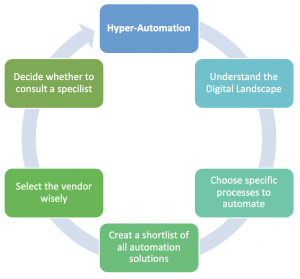Hyper-Automation: How to achieve tactical and strategic goals by automating business processes

When it comes to digitization processes in companies, hyper-automation is mentioned more and more often. Zion Market Research forecasted Hyperautomation Market is expected to grow annually at a CAGR of around 23.5 % (2022-2028), it’s was valued at approximately USD 9billion in 2021 and is projected to reach roughly USD 26.5 billion by 2028. It’s one of the big digitization buzzwords, which has come into focus not least because of Gartner’s positioning as one of the top tech trends of 2022.
According to the market research company Gartner hyper-automation is the combination of different approaches and technologies in order to get the maximum degree of efficiency out of digital possibilities, by automating automate as many business and IT processes as possible and create end-to-end workflows.
Contrary to the pure Robotic Process Automation (RPA), not only individual tasks but also complex processes can also be automated. Hyper-automation cannot be achieved without RPA, artificial intelligence (AI) and machine learning (ML). It all sounds super interesting but how can companies successfully implement this “hyper-automation”?
The first step requires a detailed mapping or analysis of the organization and back office processes to fully understand the existing workflows and identify where gaps, latencies and bottlenecks exist. On this basis, a strategy can then be developed to build bridges between the solutions and close efficiency gaps.
The next step consist of a wise selection between the different. Given the versatile requirements and complexity of many business processes, a well-orchestrated combination of different technologies is often required. A combination of artificial intelligence and machine learning to workflow tools, business process management (BPM) and robotic process automation (RPA) to low and no-code tools must be foreseen for the use of different application scenarios and problems. By linking previously mentioned technologies, the mapping of complex, cross-departmental and cross-functional workflows can be a piece of cake.
In practice, it’s equal to using process mining tools to better understand business operations & workflows, ML module to verify compliance and decision software to automate maximum tasks.
As companies are not only looking towards achieving early ROI but also focusing on optimizing processes, the vendor selection must be prioritized. The providers of different solutions are as diverse as the technologies. The objective must be to ensure that their solutions are easy and rapidly scalable. The cost of integration a technology is comparatively less than that of hiring and training a human. Therefore, organizations need to ensure the selected vendor offers solutions that can easily be integrated and configured in their existing infrastructure. Because every business is different, and there is no such thing as a one-size-fits-all way of doing business.
Before you start establishing hyper-automation in your company, you should communicate your automation initiative transparently right from the start and involve employees in the planning and implementation process. They must know how the hyper-automation is going to affect their jobs. Because you may see all the benefits, but your employees might see them differently. They may see a machine replacing them and their work. They must understand that automation increases overall productivity, lessen workload, offers the opportunity for professional growth, and can become a promoter for high-performing and efficient teams.
Organizations that want to stay competitive in the long term, must use suitable automation technologies in line with the speed and agility of digital transformation to reach the next business level.
